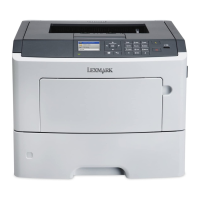Using recycled paper and other oce papers
As an environmentally conscious company, Lexmark supports the use of recycled oce paper produced
specifically for use in laser (electrophotographic) printers. In 1998, Lexmark presented to the US government
a study demonstrating that recycled paper produced by major mills in the US fed as well as non-recycled paper.
However, no blanket statement can be made that all recycled paper will feed well.
Lexmark consistently tests its printers with recycled paper (20–100% post-consumer waste) and a variety of
test paper from around the world, using chamber tests for dierent temperature and humidity conditions.
Lexmark has found no reason to discourage the use of today's recycled oce papers, but generally the following
property guidelines apply to recycled paper.
• Low moisture content (4–5%)
• Suitable smoothness (100–200
Sheeld
units, or 140–350 Bendtsen units, European)
Note: Some much smoother papers (such as premium 24 lb laser papers, 50–90 Sheeld units) and
much rougher papers (such as premium cotton papers, 200–300
Sheeld
units) have been engineered
to work very well in laser printers, despite surface texture. Before using these types of paper, consult your
paper supplier.
• Suitable sheet-to-sheet coecient of friction (0.4–0.6)
• Sucient bending resistance in the direction of feed
Recycled paper, paper of lower weight (<60 g/m
2
[16 lb bond]) and/or lower caliper (<3.8 mils [0.1 mm]), and
paper that is cut grain-short for portrait (or short-edge) fed printers may have lower bending resistance than is
required for reliable paper feeding. Before using these types of paper for laser (electrophotographic) printing,
consult your paper supplier. Remember that these are general guidelines only and that paper meeting these
guidelines may still cause paper feeding problems in any laser printer (for example, if the paper curls excessively
under normal printing conditions).
Using specialty media
Tips on using card stock
Card stock is heavy, single‑ply specialty media. Many of its variable characteristics, such as moisture content,
thickness, and texture, can significantly impact print quality. Print samples on the card stock being considered
for use before buying large quantities.
When printing on card stock:
• Make sure the Paper Type is Card Stock.
• Select the appropriate Paper Texture setting.
• Be aware that preprinting, perforation, and creasing may significantly aect the print quality and cause jams
or other paper handling problems.
• Check with the manufacturer or vendor to ensure that the card stock can withstand temperatures up to
240°C (464°F) without releasing hazardous emissions.
• Do not use preprinted card stock manufactured with chemicals that may contaminate the printer. Preprinting
introduces semi‑liquid and volatile components into the printer.
• Use grain short card stock when possible.
4514-6xx
General information
32

